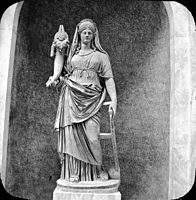구베르나쿨럼(클래식)
Gubernaculum (classical)고전 문헌에 나오는 구베르나큘럼은 배의 방향타[1] 또는 조타 [2]노를 묘사한다.영어 단어[3] government는 단어와 관련이 있다.고대 영어 단어[4] governail과 스코틀랜드 단어 guernaill은[5] 둘 다 그것에서 유래했다.
고전사
고대 방향타의 다른 부분들은 다음과 같은 이름으로 구별되었다: 안사, 손잡이, 쇄골, 축, 피나,[6] 칼날.유명한 배 '테사라콘테레스' 또는 '포티'에는 네 개의 방향타가 있었다고 한다.성경에 따르면 몰타에서 난파된 바울의 배는 방향타(복수)[7]가 [8]헐거워져 있었다.
고전적 묘사
트리톤과 비너스와 같은 다양한 신들이 구베르나큘럼과 [9]함께 보여졌다.그것은 포춘아와 함께 그녀가 들고 있는 것으로 묘사되는 물건이기 때문에 포춘아와 가장 관련이 깊다.대응하는 그리스의 신 티케 또한 정기적으로 구베르나쿨럼과 함께 나타난다.동전, 그림, 제단, 조각상 또는 조각상에 구베르나쿨럼을 들고 있는 포춘의 모습이 많이 묘사되어 있다.
Fortuna는 보통 구베르나쿨럼을 [11]들고 있는 약 1000개의[10] 로마 동전에 묘사되어 있다.
로마의 행운, 운명, 행운의[13] 신 포투나의 [12]사암 조각상이 캐슬카리에서 발견되었고 지금은 스코틀랜드 [14]글래스고에 있는 헌터리안 박물관에서 찾을 수 있다.
구베르나쿨럼을 가진 두폰디우스 포춘아
상징성과 의미
신화에서 여신이 조종할 수 있는 방향타는 삶의 변화무쌍한 운명에 대한 통제를 나타낸다.플라톤은 키를 가지고 국가의 배를 돌리는 은유를 사용했다.제임스의 성경책에서 저자는 혀를 배의 키와 비교한다. 배의 키는 신체적으로는 작지만 큰 [18]자랑거리이다.
「 」를 참조해 주세요.
레퍼런스
- ^ "Gubernaculum from Dictionary of Roman Coins". Forum Ancient Coins. The Collaborative Numismatics Project. Retrieved 12 October 2017.
- ^ Hill, George Francis, Sir (1903). Illustrations of school classics, arranged and described. London: Macmillan. Retrieved 13 October 2017.
- ^ Matthews, John (25 March 2003). Sir Gawain: Knight of the Goddess. ISBN 9780892819706. Retrieved 14 October 2017.
- ^ Dwight, William (1889–1891). The Century dictionary: an encyclopedic lexicon of the English language: prepared under the superintendence of William Dwight Whitney. New York: Century Co. p. 2585. Retrieved 13 October 2017.
- ^ Francisque, Michel (1882). A critical inquiry into the Scottish language with the view of illustrating the rise and progress of civilisation in Scotland. Edinburgh: W. Blackwood. p. 364. Retrieved 13 October 2017.
- ^ Peck, Harry Thurston (1896). Harper's dictionary of classical literature and antiquities. New York: Harper & brothers. p. 754. Retrieved 13 October 2017.
- ^ Conybeare, William John; Howson, John Saul (1861). The life and epistles of St. Paul. London: Longman, Green, Longman, and Roberts. p. 371. Retrieved 13 October 2017.
- ^ "The Shipwreck on Malta". Bible Gateway. Retrieved 13 October 2017.
- ^ Smith, William (1859). A Dictionary of Greek and Roman Antiquities. Little, Brown, and Co. pp. 788–789. Retrieved 13 October 2017.
- ^ "Fortuna Coins". Online Coins of the Roman Empire (OCRE). American Numismatic Society and the Institute for the Study of the Ancient World at New York University. Retrieved 12 October 2017.
- ^ "Late Roman Coins with Fortuna, from the period of the first tetrarchy at the end of the third century AD". Ancient Roman and Greek Coins: Educational pages. Retrieved 12 October 2017.
- ^ "Fortuna". The Magical Art of Thalia Took. Retrieved 12 October 2017.
- ^ "Fortuna & The Wheel of Fortune". Exploratory Shakespeare. Retrieved 12 October 2017.
- ^ "The Antonine Wall: Rome's Final Frontier". The Hunterian. University of Glasgow. Retrieved 10 October 2017.
- ^ "statuette of Fortuna". Hunterian Museum & Art Gallery Collections: GLAHM F.43. University of Glasgow. Archived from the original on 13 October 2017. Retrieved 13 October 2017.
- ^ "Roman statuette of Fortuna". BBC - A History of the World. Retrieved 12 October 2017.
- ^ MacDonald, James (1897). Tituli Hunteriani: An Account of the Roman Stones in the Hunterian Museum, University of Glasgow. Glasgow: T. & R. Annan & Sons. pp. 90–91. Retrieved 11 October 2017.
- ^ "Taming the Tongue". Bible Gateway. Retrieved 9 November 2017.



![Statuette[15] of the Roman goddess Fortuna, with gubernaculum (ship's rudder),[16] Rota Fortunae (wheel of fortune) and cornucopia (horn of plenty) found near the altar at Castlecary in 1771.[17]](http://upload.wikimedia.org/wikipedia/commons/thumb/7/78/Titulihunteriani00macdrich_raw_0143.png/144px-Titulihunteriani00macdrich_raw_0143.png)


